Novel Concept for Unloading and Stacking Improves Steel Manufacturer's Capacity, Quality and Safety
With 47 facilities across North America, Olympic Steel specializes in cutting and forming sheet metal. When the Georgia-based manufacturer needed to figure out a better way to automate the stacking process of the metal blanks, they turned to production system specialist AP&T -- and the company came up with a whole new concept.
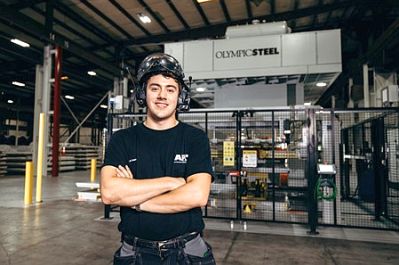
Starting with prints for a new production line, AP&T created a solution in which blanks are produced in a fully automated process. Keith Kasler, Applications Engineer at AP&T, is one of the team members mainly involved in Start-Up, Commissioning, and Training.
At Olympic Steel's facility in Winder, Georgia, sheet metal blanks are produced for forming companies in various industries around North America. The blanks are processed into complete components on the customer site and the finished product could be anything from cars to agricultural machinery. This means that the blanks produced in Winder vary greatly in shape and size, which means their production equipment must be flexible.
The manufacturer offers a full portfolio of products, including carbon and coated sheet, plate, and coil products; stainless steel sheet, plate, bar and coil; aluminum sheet, plate and coil; pipe, tube, valves and fittings; tin plate and metal-intensive branded products, including commercial and residential ventilation and air filtration products, self-dumping hoppers and dump inserts.
VIDEO: Olympic Steel increased productivity with automated stacking system from AP&T
"At the beginning of 2021, we booked an unconditional meeting with Olympic Steel to learn if and how we could help optimize their new blanking line in the Winder facility," says Johan Johansson, Lead Senior Electrical & Software Designer at AP&T North America.
The timing couldn't have been better.
"When AP&T approached us, we were looking for a solution that could automate the stacking process of automotive blanks, improve overall production speed, and minimize downtime associated with manual handling as well as solve the safety related issues associated with manual handling," explains Ryan Hall, Blanking Manager at Olympic Steel.
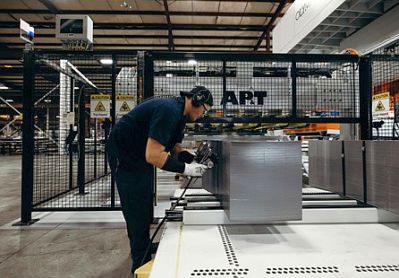
The new process has resulted in an entirely novel quality level of completed blanks in varying sizes and shapes.
The discussions led to an entirely new AP&T concept for automated blank unloading and stacking. A solution in which blanks are produced in a fully automated and fully integrated process.
"AP&T suggested a very interesting solution and concept. The prospect of an automated blank stacker promised to address our challenges by streamlining the stacking process and reducing human intervention. There was also potential for increased production speed, productivity and safety," says Hall.
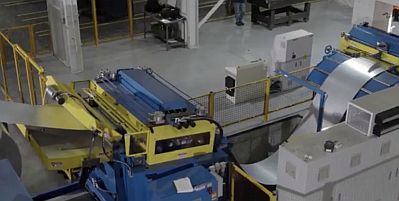
This is this the first fully automated blanking line for Olympic Steel and also the first stacking system of this type that AP&T has designed.
The challenge was to design a system that could handle large volumes of differently shaped blanks quickly and efficiently, without mechanical impact.
"Instead of developing everything from scratch, we chose to base the system on our tried and tested standard modules. Our basic program of linear robots, SpeedFeeders, were perfect for the purpose," says Robert Leff, a former mechanical solutions engineer with AP&T North America.
The system that was installed and made operational in the summer of 2022 included a total of 12 positioning arms based on AP&T's SpeedFeeders, a number of conveyors and two pallet stations that are moved automatically. Once the sheet metal blank has been precisely cut in the press, it is first moved over to a telescopic conveyor and then to a magnetic conveyor. The positioning arms then ensure that each blank ends up in exactly the right position. Finally, the blanks end up on a hydraulic scissor table that gradually lowers as the stack of components grows.
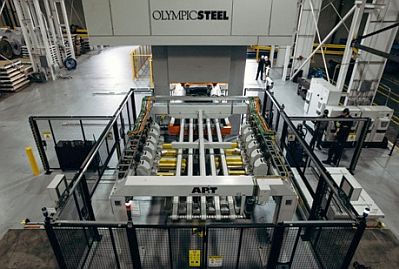
Twelve positioning arms ensure that each blank ends up in exactly the right position.
This provides Olympic Steel with an entirely novel quality level of completed blanks in varying sizes and shapes. They have gone from operators limiting the output to having the machine in control and producing at maximum capacity. They have also managed to reduce the risk of personal injury.
The automation of the stacking process has resulted in reduced manual labor requirements, minimizing the risk of human errors and enhancing the speed of production. Downtime related to manual handling has been significantly reduced, leading to increased overall output.
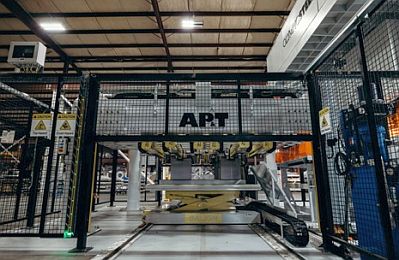
Finally, the blanks end up on a shearing table that gradually lowers as the stack of components grows.
"We are now often able to run our blanking line at, or close to, full speed, contributing to a more streamlined and efficient operation. Safety has also increased due to the fact that human hands are not involved with the stacking process, which greatly reduces the safety risks present in manual processes," says Hall.
AP&T's Johansson is proud of the result.
"Not only is this the first fully automated blanking line for Olympic Steel in Winder, but it is also the first stacking system of this type that we have designed. It has been a very interesting collaboration for both parties, to say the least," he says.
Want more information? Click below.
Rate this article
View our terms of use and privacy policy ::m::